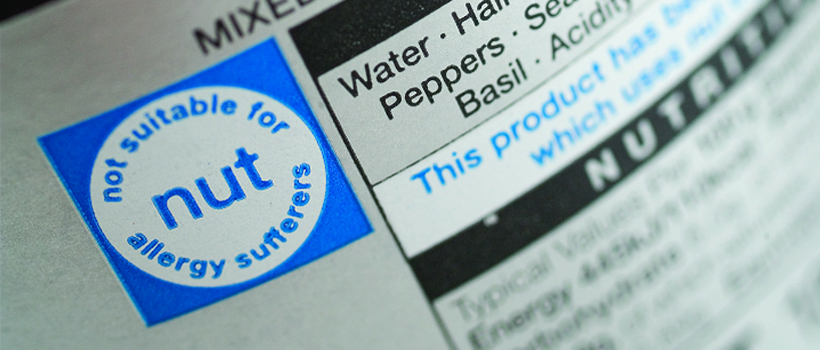
What is allergen management and why is it business critical?
19 September 2025 | Wendy Duncan, Safety, Quality and Allergens Manager
The number of people with food allergies continues to increase with 44% of British adults currently suffering from at least one allergy – according to Allergy UK.
Given the rise of consumers with food hypersensitivities, where individuals can experience adverse reactions to specific foods, ranging from mild irritation to potentially life-threatening anaphylaxis, the need for effective allergen management has never been more crucial.
In fact, failure to manage allergens effectively can not only lead to serious consumer health risks, but the threat of product recalls, business reputation and legal repercussions for food business operators.
This blog will delve into the issue of food allergen management in more detail, offer some top-level considerations for putting a food allergen management system in place, and provide some details about how Campden BRI can support businesses looking to strengthen their allergen controls.
What is food allergen management?
To begin with, it is helpful to explain what we mean by food allergen management.
Essentially, food allergen management refers to the practices and procedures that are put in place to identify, control, and communicate the presence of allergens in food to protect consumers - especially those with food allergies - from accidental exposure. It is a critical part of food safety in both manufacturing and food service environments.
Considering that the allergens issue shows no sign of abating – ‘undeclared allergens in food products now accounts for over half of all food recalls in the UK according to The Food Standards Agency’ - effective allergen management should be no longer be a choice but a necessity.
Proactivity is the key to improving food allergen management
While it is essential to have a food allergen management system in place, the biggest challenge with allergens is that not only are they often already present in foods, but they can be inadvertently introduced in multiple ways throughout the food supply chain.
From residual food allergens that remain on equipment and inadequate segregation of food product lines to insufficient cleaning or training of staff; the potential sources of cross-contact can be numerous and varied. However, while this can sometimes make them challenging to manage, a proactive - rather than a reactive approach which is usually too late - still offers the best defence against allergen incidents arising.
The value of allergen mapping
At this point it is useful to highlight the value of allergen mapping as part of a proactive food allergen management approach.
By helping you to establish a visual guide about the location of allergens and the areas and process steps most at risk from allergen cross contact, allergen mapping is a great tool to identify and track allergens throughout your facility.
The codex approach to food allergen management
Similarly, the Codex Alimentarius Commission (Codex) offers a code of practice on food allergen management for food business operators.
The Codex code of practice (COP) states that food allergen management systems and their control measures should be based on risk assessment conducted by the food business operator, in which they must identify the allergenic nature of the foods they handle and establish controls. This is to help eliminate or minimise the potential for introducing unintended food allergens through cross-contact, or for undeclared food allergens to be present due to errors in the supply chain. The provision of accurate food allergen information for consumers of foods sold loose (for example in food service) and on the labelling of prepacked foods is also emphasised as an objective for the food allergen management plan.
Key considerations for an effective food allergen management system
To help mitigate or eliminate the risks of food allergen cross-contact and inaccurate labelling issues, an effective food allergen management system should be put in place. This needs to run in tandem alongside good hygiene practices (GHPs) and the implementation of effective HACCP systems.
When it comes to developing an effective food allergen management system, some key considerations for this should include, but are not limited to equipment, segregation, cleaning and training.
Equipment
The first area to consider is your equipment. Residual food allergens can remain on equipment, so cleanable and/or dedicated equipment should be used for this.
Use fit-for-purpose, hygienically designed equipment that does not allow food allergens to get stuck or accumulate. Any equipment should also facilitate effective cleaning with appropriate agents
Segregation
There are a number of areas to consider if you are to effectively segregate your processes and help mitigate the risk of allergen cross contact:
- Space – place foods that do not contain allergens on shelves above those that do contain allergens and, if possible, separate their storage and handling areas. You also want to use dedicated equipment and processing machinery, if at all possible.
- Time – when it is not possible to have designated processing lines for products of differing allergen profiles, pay attention to the sequence of different processing steps, such as the running order of different products and where your cleaning falls within this. An optimal order should help to minimise the risk of food allergen cross contact to products not containing those food allergens.
- Personnel – where possible, try to assign different personnel to tasks involving foodstuffs that do not contain allergens and those that do.
Cleaning
For any cleaning chemicals that you use, try to ensure that they are compatible with your equipment and do not cause corrosion or other issues that may lead to harbourage of allergen-containing food soil. Cleaning should be effective and repeatable, and its effectiveness at removing relevant allergens must be validated and verified.
Training
Within any food processing environment, personnel and their protective clothing can unintentionally act as allergen cross-contact vectors. So, it is essential that all personnel are well-trained, and adhere to, best practice processes and procedures.
Any training should also facilitate awareness and competence in taking active steps to avoid food allergen cross-contact.

Don’t forget about food allergen labelling
At this point it is helpful to talk about the issue of food allergen labelling, as this also has a significant role to play in protecting consumers and food business operators.
While the retained Regulation (EU) No 1169/2011 was introduced to protect consumers with food allergies, by requiring relevant allergenic food to be indicated on labelling where specified allergenic foods (or their derivatives) were used as ingredients in prepacked foods – the situation is more complex where allergens are unintentionally present in products as a consequence of cross-contact.
In this scenario, using ‘may contain X’ labelling, which follows more recent developments in precautionary allergen labelling, can help, but it is far more prudent to ensure that the right processes, procedures and training are put in place to stop this situation from arising in the first place. In addition, it is crucial to ensure that the correct labels are applied to every product, every time.
How Campden BRI can help
Food allergens is a challenging and ever evolving issue, but with the right support and allergen controls in place it is something you can manage effectively.
Thanks to the breadth and depth of our expertise, we can cover every aspect of the food allergen services process. And because allergens touch so many aspects of production – from supplier approval to final packaging – our multidisciplinary team can step in to support you at any stage.
We can provide training tailored to your site and product range, or general allergen management courses. We provide consultancy for both proactive planning and reactive incident support and can carry out gap analyses of allergen management policies and procedures, often combining desk-based reviews with site visits to see controls in action. Our services also include support with food allergen management, labelling and legislation. In addition, we can also arrange and interpret testing to verify cleaning effectiveness and detect allergens.
If after reading this, you have any questions about allergen management, we are also offering a free 20-minute consultation with Wendy.
Want some advice?
Got a question related to the ongoing prevention and monitoring of allergen cross contact?
Find out more
We provide tailored, expert support in all areas of food allergen management







